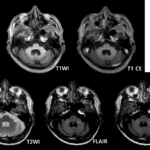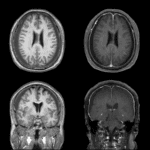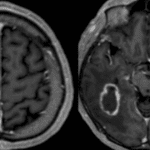Creutzfeldt-Jakob disease
Creutzfeldt-Jakob disease (CJD) is a rare, degenerative, and ultimately fatal brain disorder. It belongs to a group of conditions known as transmissible spongiform encephalopathies, which are caused by abnormal proteins called prions. These proteins can cause brain tissue to become sponge-like, leading to the characteristic symptoms of CJD.
- Imaging finding of Creutzfeldt-Jakob disease
- Best diagnostic clue : Progressive T2 hyperintensity of basal ganglia (BG), thalamus, and cerebral cortex
- CT : Usually normal
; may show rapidly progressive atrophy and ventricular dilatation on serial imaging - MR
- T1WI : normal
- T2WI
- Hyperintense signal in BG, Thalami, Cortex
- Cerebral atrophy
- With time, hyperintense foci may develop in WM
- FLAIR
- 2 signs seen in 90% of vCJD but can also occur in sCJD
– “Pulvinar” sign: Bilateral symmetrical hyperintensity of pulvinar (posterior) nuclei of thalamus
– “Hockey stick” sign: Symmetrical pulvinar and dorsomedial thalamic nuclear hyperintensity - Periaqueductal GM hyperintensity
- Cortical hyperintensity (common in sCJD)
- 2 signs seen in 90% of vCJD but can also occur in sCJD
- DWI
- Progressive hyperintensity in striatum and cortex
- Gyriform hyperintense areas in cerebral cortex (“Cortical ribbon” sign)
– Correspond to localization of periodic sharp-wave complexes on EEG - DWI hyperintensity may disappear late in disease
- T1WI C+: No enhancement of lesions
- Location
- Predominantly gray matter
- BG: Caudate and putamen > globus pallidus
- Thalamus (common in vCJD)
- Cerebral cortex (most commonly frontal, parietal, and temporal lobes)
; Often asymmetric
White matter usually not involved



Symptoms of CJD
typically develop rapidly and may include memory loss, behavioral changes, visual disturbances, difficulty walking, and eventually, coma and death. The disease is caused by abnormal prion proteins that damage brain cells and cause them to die.
Treatment of CJD
There is no cure for Creutzfeldt-Jakob disease (CJD), and treatment is primarily supportive, with the goal of managing symptoms and improving quality of life. Treatment may include medications to control symptoms such as seizures, as well as physical therapy to help with mobility and other supportive care.
See more about neuroimaging
Follow my instagram




